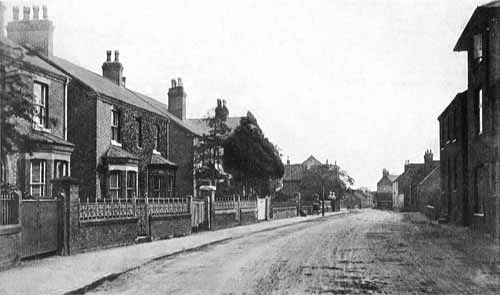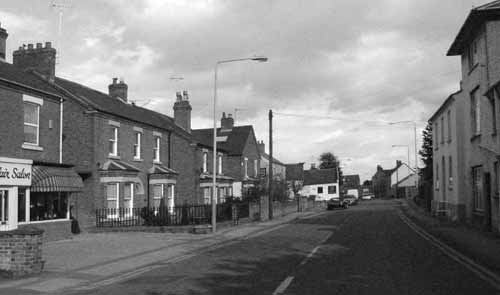![]()
Long Acre looking east from Tithby Road/Fairfield Street junction

c.1903

2003
The row of villas on the left, built between 1880 & 1887 by local farmer and builder, James Walker, have undergone only superficial changes over the 100 years that separate the two pictures. Unusually, all of the chimney stacks remain but only Nos. 7 & 9 appear to retain the original Victorian chimney pots. The houses, Nos. 1 (out of shot), 3 & 5 are double-fronted villas with a carriage entrance to the rear of the properties. The original stables still remain at the rear of No. 5. All the double gates to the drives and the front walls with railings have gone. In the case of No. 3 the front garden has been tarmaced and the ground floor bay windows and arched front doorway were hidden by the conversion to a hairdresser’s premises.
Nos. 7 to 15 are more modest semi-detached houses, Nos. 11 and 15 (note no ‘unlucky’ No. 13!) have their gable end facing the road. In 1903, yew trees obstruct the view of No. 17, the largest house in the development that was, up to the late 1900s, Squires monumental masons and is now occupied by a Funeral Director’s offices with accommodation on the first floor. The original ornamental brick gate piers have been removed. The name ‘Squires’ can be seen at the base of many gravestones in the parish churchyard and the cemetery.
Beyond, can be seen the roof of one of the oldest houses in Bingham, No. 21 Long Acre. This, originally thatched, single-storey farmhouse dates from c.1650. In the mid-1800s the lower extension onto the road was added and served as a butcher’s shop for many years, it is now a florist’s. Probably at about the time this extension was built, the farmhouse roof was tiled and since then the chimney stack has gone. Over the ridge can be seen the gable end of the 1818 Primitive Methodist Chapel, now The Horse and Plough. The remaining buildings in the distance on this side of Long Acre can be seen more clearly on the comparison pictures taken from the junction with Market Street.
We know that the town roads were paved around 1870 and the continuous pavement on the north side is evident but in the 1903 picture one could be excused for thinking that it is an earth road surface. The poor condition is, no doubt, due to mainly horse-drawn traffic and cattle movements in and out of Walker’s Farm, which was still operating together with the owner’s house building activities.
On the south side there is no continuous pavement in 1903 but both No. 2 & 4 are little changed externally, except for a coat of white paint in recent years. Although obscured by No. 4, No. 6 Carnarvon House existed when the 1903 picture was taken; the front garden brick boundary wall can be seen in the picture. The Edwardian style houses, Nos 8 & 10 were not built until about 1913. The next cottages in the photograph, were probably Nos. 12 & 14 demolished for the Walker Close development in the 1970s. No.16 survives, this was the home of the farm dairyman until the new development.
The view ends with the west gable end of the Wheatsheaf pub and between this and No.16 was an orchard and farm cottages or barns set back from the road. Most of this was cleared to build The Paddocks later in the 70s. Some of these buildings were converted into dwellings as Nos. 21 & 23 The Paddocks. Behind No. 22, ‘The Old Orchard’ modern bungalow is a much older house (c.1860), No.24 Cooper Cottage, and an earlier Cooper’s workshop which was converted to additional accommodation in the 1970s.
